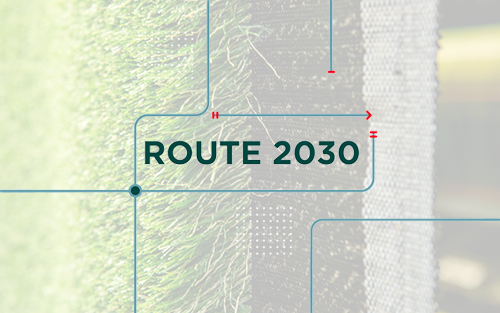B.I.G. is on course to achieve a zero environmental footprint by 2030. That is right, zero. To make this journey more tangible, we would like to offer you a passenger’s seat from which you will be able to really get up close and immerse yourself in our various sustainability projects. In this edition: Weaving sustainability from yarn to yard.
The concept of sustainable artificial grass may seem contradictory, but at B.I.G., efforts are underway to make our artificial grass recyclable and produced from entirely recycled materials. "Changing the perception of artificial grass is still quite a challenge," says Nuria Villena Lerin, R&D Manager Artificial Grass. "It is often dismissed as plastic replacing something natural. And to be clear, that's what it is. However, there are also numerous associated benefits. I'm thinking, in particular, about maintenance costs, the reduction of chemical products entering our environment, and the significant amount of water lost in lawn maintenance."
Developing sustainable solutions
In the development phase, three key pillars guide the approach of B.I.G.: the backing of the grass mats, incorporating recycled content, and utilizing natural infill products. “The initial focus is on creating market solutions with yarns made from recycled content, moving away from virgin materials. We use sustainable yarns, both produced in-house and externally, to set the stage for environmentally friendly artificial grass”, Nuria states.
Eco-friendly backing
Once the grass mats are tufted with sustainable yarns, the entire assembly needs to be joined together with a backing. Frequently, the non-sustainable product latex is still used for this purpose. We, and the industry as a whole, are actively seeking solutions to make this backing environmentally friendly. “We've already introduced products to the market featuring a backing made from the same component family as the other elements of artificial grass. This results in a product composed of a consistent product family, significantly simplifying the recycling process", Nuria explains. “We want to provide 100% recyclable grass for the landscape and residential markets in 2025. When the time is right, we also aim to establish a takeback system to handle recycled content from our own grasses. We want to close the loop.”
Incorporate recycled content
For large sports grass areas without an ecofriendly backing, take-back processes are already in place, allowing recycling companies to separate and valorize the different components of the artificial grass. "Recycling companies can separate the sports grass into various layers, each of which can be valorized. For us, the layer with the yarns is particularly crucial, as we can reuse them in our artificial grass processes. However, Beaulieu International Group has a diverse range of products where this recycled content can be incorporated”, according to Nuria.
Infill alternatives
“To address the environmental impact of infill materials, we are investigating alternatives to rubber to address potential rubber infill issues in the future. Experimentation with materials like olive pits or cork as substitutes is underway, and there's even consideration of infill-free alternatives, though these may require different production processes.”
Towards an ideal world
Nuria envisions a future where products made from sustainable yarns are self-recovered, recycled, and seamlessly reintegrated into the production process. This ideal world relies on responsible practices, minimal pollution, and the widespread availability of recyclable products. “In all honesty, I found it challenging to cope with the fact that I contribute to potential plastic pollution. But that's also my motivation. Because, even if I weren't here, artificial grass would still be produced, so I might as well do something to help make it sustainable. That's where I draw my energy from. And that mindset is shared by everyone at B.I.G.", concludes Nuria.
